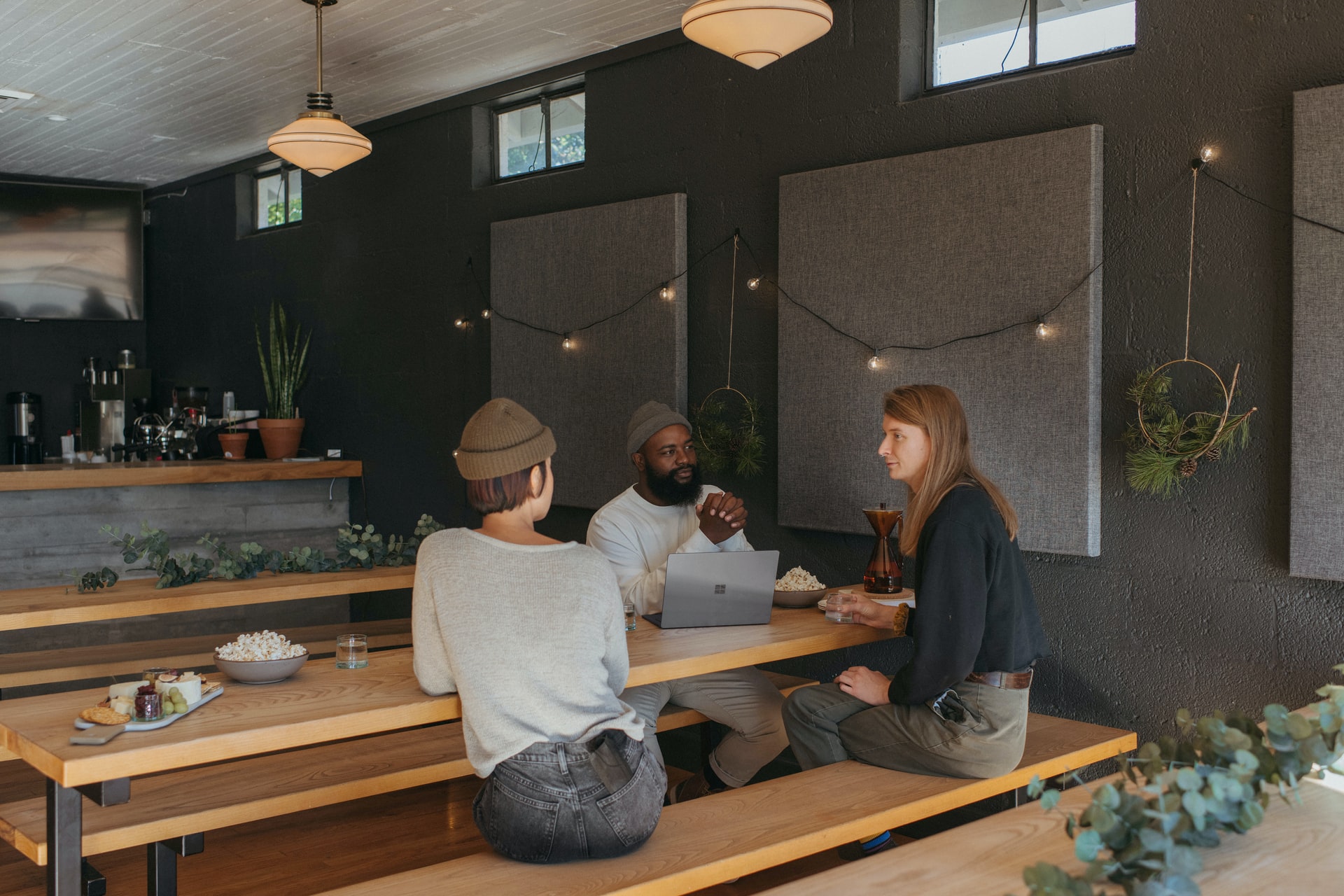10 striking statistics about the coworking sector
In June 2021, a report by Research and Markets revealed that the global coworking market is expected to grow from $7.97 billion in 2020 to $8.14 billion in 2021.
This is just one of many optimistic coworking statistics out there today.
Coworking has come a long way since its humble beginnings. The concept’s roots can be traced back to 1995, when C-base opened as one of the first hackerspaces in the world.
Hackerspaces are community-focused, providing tech workers and entrepreneurs with a physical location where they can work, meet and exchange skills. Experts often hark back to hackerspaces as the first coworking pre-models, and they’re still going strong today.

The term “coworking” was coined in 1999 by Bernard DeCoven.
“When I coined the term ‘coworking,’ I was describing a phenomenon I called ‘working together as equals.’ I was exploring how the insights I gained in designing games and facilitating play could apply to the facilitation of work,” writes Bernard.
Concurrently, a work club popped up at 116 West Houston in NYC, designed for people working in the creative industries. In an interview, its founder described how “it’s the community that brings value,...not the resources or type of desk.
“People are here to work. If you’re around 20 other people who are working, there’s a buzz, an energy that inspires you...If you put up walls, there’s no point.”
Fast forward to the 2000s and a number of coworking spaces - as we know them today - began to open their doors to individuals and businesses across a range of industries.
In recent years, the concept has evolved to take on many different forms. There’s coworking for corporates, workspaces for digital nomads, sector-specific work hubs and more.
Although coworking accounts for under 10% of total office stock, the sector is continuing to gain traction at a time when organisations are looking to leverage flexible business solutions.
Striking statistics about today’s coworking scene
1. The number of coworking spaces worldwide is expected to reach 40,000+ by 2024 - double the number in 2021.
(Source: Global Coworking Growth Study)
2. Research predicts the coworking space market will grow by 2.1% in 2021, from $7.97 billion in 2020 to $8.14 billion. However, it’s expected to reach $13.03 billion by 2025, at a compound annual growth rate of 12%.
(Source: Coworking Space Global Market Report 2021)
3. In 2020,86% of US firms said their long-term real estate strategy includes flexible and coworking spaces. Top reasons include to “provide a network of locations for more mobile workforce access” (45.5%); “enter a new market(s)” (43.9%); “short-term space solution for temporary dispersed workforces” (42.4%) and “reduce capital expenditure” (40.9%).
(Source: The End of the Beginning, North America Flexible Office Market in 2020)
4. Asia Pacific has the most coworking spaces (5,889), followed by Europe (5,858) then North America (4,698).
(Source: Global Coworking Growth Study)
4. Forecasts reveal a predicted flexible workspace growth of over 21% in 2021.
(Source: 2021 CRE Predictions)
5. 90% of Colliers’ Occupier Services poll respondents projected lease flexibility will increase in the future. 25% believed this will take the form of more flexible workspace agreements, with another 44.5% indicated that greater flexibility will be built into traditional leases.
(Source: Flex Forward: The Flexible Workspace Report 2020)
6. 71.5% of workers that used coworking prior to the pandemic plan to return to it, while 54.9% of remote workers that didn’t use coworking before said they’d consider joining a coworking space as a remote work solution in the future.
(Source: 2020 Future of Work Report)
7. 66% of workers want the ability to alternate between different places of work post-pandemic. Of those surveyed, 40% would like the option to work from a third-party place such as a coffee shop or a coworking space, up 11% since COVID-19 began.
(Source: Shaping Human Experience)
8. In 2020, 20% of corporate workers in the US used coworking spaces at least one day a week, an increase from 14% in 2019. Their use of the space was in addition to their primary workplace, and access to an alternative office space had a positive impact on their job performance.
(Source: U.S. Workplace Survey 2020)
9. In the UK, 30% of flexible workspace providers reported that occupancy rates remained relatively stable through the 2020 global lockdown, falling by just 10%. On average, operators reported demand for flexible space at 52% of pre-Covid levels. However, some suburban markets experienced significant growth and prices increased.
(Source: The Changing Face of an Industry: UK Flex Market Review)
10. 90% of Latin American coworking operators are planning to expand over the next 12 months, and over the last ten years, Latin America has had a 230% growth in supply, compared to the 196% growth in the U.S. in the same period.
(Source: The growth of Flexible Workspace in Latin America)

The future is bright for coworking
At a time when people around the world are reevaluating their working practices, one thing has become apparent: there is still a need for the office.
More than ever, businesses are looking to leverage flexible workspaces to create cohesion between team members and to attract and retain talent.
Coworking spaces will play a crucial role in economic recovery. They provide businesses with a space in which to meet and grow, and moving forward, will play an even greater role as a networking and learning resource for local communities.
At Nexudus, we support coworking operators and help them grow by providing them with technology to manage their buildings and communities effectively.
If you’re interested in learning more, get in touch today.
Related stories
Connection, Belonging, Identity: Why Branding Matters When You’re Building Your Community
Guided by industry insights, we navigate the intricate landscape of branding, probing fundamental questions posed by thought leaders like Cat Johnson. Beyond logos and colour schemes, we uncover the essence of brand identity.
Elevating mixed-use spaces: The crucial role of hospitality and technology in community management
As mixed-use developments continue to grow in popularity, merging visitors with locals through a high level of hospitality, and community, in whatever way the space functions, is of prime importance.
The glorious renaissance of community-led coworking
Join us in exploring how the coworking movement transcends beyond just providing desks and chairs- it's a catalyst for community and collaboration.
3 Things People Want From Their Workplace Experience
According to Appspace’s 2023 Workplace Experience Trends & Insights Report, 93% of people who work in an office think their organisation could do more to improve the workplace experience. To craft a truly exceptional workplace experience, it’s useful to know what people are actually looking for in an office environment – which, of course, can change over time. So, we decided to do a little digging.
Overturning a Man’s World: How Coworking Supports Women - Part 2
In this follow-up to the recent blog post, Overturning a Man’s World, we continue an exploration of how coworking supports women.
Building an Inclusive Workplace Experience at Huckletree
Huckletree, a longstanding customer of Nexudus, has a growing network of shared workspaces across the UK and Ireland. It represents a community of over 4,000 people working across dynamic tech and creative sectors including web3, fintech, AI, govtech, and sustainable innovation.
How To Make Your Coworking Software Work For Your Brand
With so many new and interesting coworking offerings emerging, it’s never been more vital for existing spaces to differentiate themselves and stand out. And one of the best ways to achieve this is by establishing a strong brand presence.
Behind The Desk: Meet Our Founders
Welcome to, where we dive deep into the brains behind Nexudus. Today, we’re chatting with Nexudus’ CTO and co-founder Adrian, as he shares his journey from selling Internet Cafe technology to being the co-founder of a global coworking company.
Creating Future-Ready Workspaces with Nexudus' Experts 🌍
We sat down with Stephen Wood, Nexudus’ North America Account Lead and our North American technology partner, Serge Rose, to talk about their recent collaboration in assisting a Canadian client with their migration to Nexudus and to delve into their thoughts on the future of technology in workspaces moving forward!
Overturning a Man’s World: How Coworking Supports Women
From beer taps to thermostat settings, we're examining how coworking can be a game-changer for women at work.

